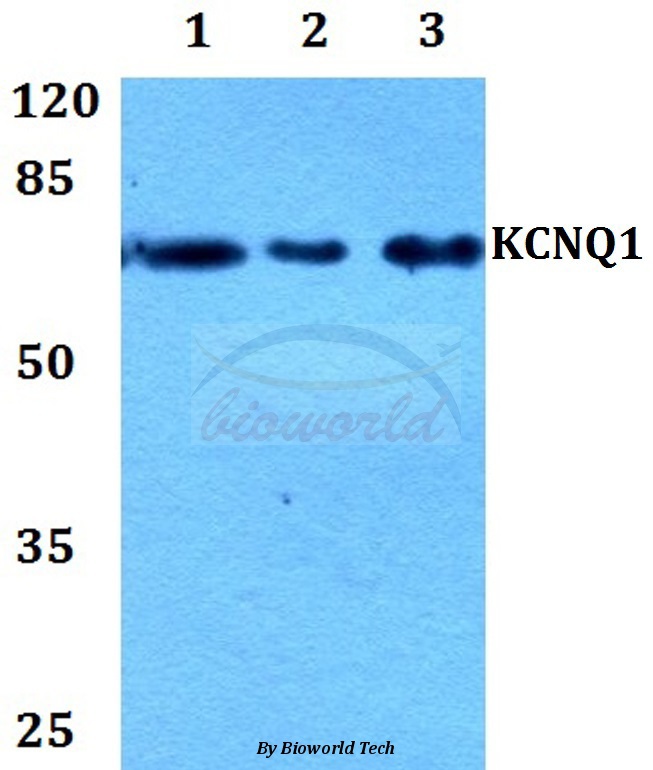
Figure 1. Western blot analysis of KCNQ1 using anti-KCNQ1 antibody (A00310-1). Electrophoresis was performed on a 5-20% SDS-PAGE gel at 70V (Stacking gel) / 90V (Resolving gel) for 2-3 hours. The sample well of each lane was loaded with 30 ug of sample under reducing conditions. Lane 1: human THP-1 whole cell lysates, Lane 2: rat stomach tissue lysates, Lane 3: rat lung tissue lysates, Lane 4: rat PC-12 whole cell lysates, Lane 5: mouse stomach tissue lysates, Lane 6: mouse lung tissue lysates, Lane 7: mouse NIH/3T3 whole cell lysates. After electrophoresis, proteins were transferred to a nitrocellulose membrane at 150 mA for 50-90 minutes. Blocked the membrane with 5% non-fat milk/TBS for 1.5 hour at RT. The membrane was incubated with rabbit anti-KCNQ1 antigen affinity purified polyclonal antibody (Catalog # A00310-1) at 0.5 microg/mL overnight at 4°C, then washed with TBS-0.1%Tween 3 times with 5 minutes each and probed with a goat anti-rabbit IgG-HRP secondary antibody at a dilution of 1:5000 for 1.5 hour at RT. The signal is developed using an Enhanced Chemiluminescent detection (ECL) kit (Catalog # EK1002) with Tanon 5200 system. A specific band was detected for KCNQ1 at approximately 75 kDa. The expected band size for KCNQ1 is at 75 kDa.
Anti-KCNQ1 Antibody Picoband(r)
A00310-1-CARRIER-FREE
ApplicationsFlow Cytometry, ImmunoFluorescence, Western Blot, ImmunoCytoChemistry, ImmunoHistoChemistry
Product group Antibodies
TargetKCNQ1
Overview
- SupplierBoster Bio
- Product NameAnti-KCNQ1 Antibody Picoband(r)
- Delivery Days Customer9
- ApplicationsFlow Cytometry, ImmunoFluorescence, Western Blot, ImmunoCytoChemistry, ImmunoHistoChemistry
- CertificationResearch Use Only
- ClonalityPolyclonal
- Concentration500 ug/ml
- Gene ID3784
- Target nameKCNQ1
- Target descriptionpotassium voltage-gated channel subfamily Q member 1
- Target synonymsATFB1, ATFB3, JLNS1, KCNA8, KCNA9, KVLQT1, Kv1.9, Kv7.1, LQT, LQT1, RWS, SQT2, WRS, potassium voltage-gated channel subfamily KQT member 1, IKs producing slow voltage-gated potassium channel subunit alpha KvLQT1, kidney and cardiac voltage dependend K+ channel, potassium channel, voltage gated KQT-like subfamily Q, member 1, potassium voltage-gated channel, KQT-like subfamily, member 1, slow delayed rectifier channel subunit, voltage-gated potassium channel subunit Kv7.1
- HostRabbit
- IsotypeIgG
- Protein IDP51787
- Protein NamePotassium voltage-gated channel subfamily KQT member 1
- Scientific DescriptionBoster Bio Anti-KCNQ1 Antibody Picoband® catalog # A00310-1. Tested in Flow Cytometry, IF, IHC, ICC, WB applications. This antibody reacts with Human, Mouse, Rat. The brand Picoband indicates this is a premium antibody that guarantees superior quality, high affinity, and strong signals with minimal background in Western blot applications. Only our best-performing antibodies are designated as Picoband, ensuring unmatched performance.
- Storage Instruction-20°C,2°C to 8°C
- UNSPSC12352203












